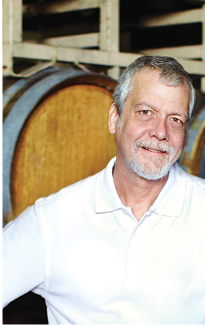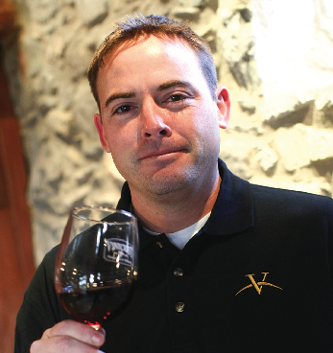Developed commercially 50 years ago, Chambourcin is a versatile grape that is most prevalently grown in the Mid-Atlantic. Producing deep red colors and strong aromas, Chambourcin grapes are used either to stand-alone or in blended wines that run the gamut from dinner wines to dessert wines to sparkling wines.
 Rick Hall joined Chateau Morrisette in Floyd, Virginia, as a production worker in 2000 and became Winemaker in 2008. He has degrees in Biological Science from Virginia Tech and Culinary Arts from Johnson and Wales University. Rick believes winemaking is best practiced as a passionate fusion of art and science. With a background in both areas, he draws from his experience in the culinary arts and strives to create wines that are at home with a variety of cuisines.
Rick Hall joined Chateau Morrisette in Floyd, Virginia, as a production worker in 2000 and became Winemaker in 2008. He has degrees in Biological Science from Virginia Tech and Culinary Arts from Johnson and Wales University. Rick believes winemaking is best practiced as a passionate fusion of art and science. With a background in both areas, he draws from his experience in the culinary arts and strives to create wines that are at home with a variety of cuisines.
Chambourcin is a fairly unique wine grape variety that generally makes dramatically dark red wines, almost purple in color, while having only a moderate amount of tannins. The mild complement of tannins makes Chambourcin a very approachable red wine for folks who generally prefer white wines.
Chambourcin wines are generally very rich in character, with deep, dark fruitiness. They can be paired with a variety of foods, including grilled or roasted meats, stews, pasta dishes with tomato sauce, mushroom dishes, and chocolate.
It is also an extremely versatile grape: It makes an excellent stand-alone varietal, such as our 2011 Chateau Morrisette Chambourcin or our Dry Rosé wine from 100% Chambourcin grapes. It is also used in wine blends, sometimes just a bit to augment color and fruitiness, other times it can be a large part of the blend. We have numerous wines that use Chambourcin as the primary grape variety, including our unconventional, head-turning Port-style wine.
If you are well-versed in making home wine right from the grapes, making Chambourcin would be like making any other red wine.
Ideal conditions to grow Chambourcin require a site that is well-drained, not at all shaded, free of spring frosts, and generally above 0 °F (-18 °C) in winter. Sites that may be too “rich” with nitrogen nutrients such as riverside bottomlands should be avoided. Winds, outside storms and hurricanes are not a big problem and help the clusters dry out after a rain.
Much of Virginia’s wine grape country is quite well suited to growing Chambourcin. Indeed, Virginia may be one of the best places there is to grow this interesting and delicious variety.
Due to the usually high vigor of Chambourcin, which means the plants like to produce lots of vine and leaves, the trellising system is chosen to help organize that vigorous growth. Most growers use a “High Cordon” or “High Wire” trellising system, which gives the vines a lot of room for their vigorous production of leaves without creating a shaded jungle in the fruit zone below the canopy. That is only part of the story, though, as there is generally the need to remove a fair amount of the leaves from the canopy along the high wire, called “hedging,” and the need to remove excess leaves from the fruit zone, called “leaf pulling.” The viticulturist growing the Chambourcin is then rewarded with a crop that has good disease resistance— which can minimize other work in the vineyard.
Typical yields for Chambourcin in established Virginia vineyards are in the three to five tons per acre range.
We don’t own enough land to grow the many hundreds of tons of grapes we need to satisfy our customers’ demands, so we contract with over a dozen different Virginia wine grape growers to help supply our needs. This year we expect to harvest Chambourcin from seven of these partner vineyards. Each has its own particular combination of climate and soil type, so each grower’s Chambourcin differs from the others in some ways. In general, however, Chambourcin performs very well across the Commonwealth.

Sam Landis is the second generation of his family to work at their Vynecrest Winery in Breinigsville, Pennsylvania.
Like most hybrids, Chambourcin is more resistant to many diseases and, by and large, much less likely to die within the first five years as opposed to other red vinifera in our vineyard. At the same time, Chambourcin has the ability to showcase itself right up there with other red vinifera from a wine quality point of view.
We go with High Wire Cordon with our Chambourcin and do a lot more cluster thinning with our dry oak-aged Chambourcin vineyard blocks than our semi-sweet vineyard blocks. We have found that thinning to one cluster per shoot has made a huge difference in the quality of our dry Chambourcin wines. Without thinning, most Chambourcin plants will put out three, even four clusters per shoot, which will really impact the juice/wine on the back end. Chambourcin has the ability to produce anywhere from 5 to 7 tons per acre, but we aim for 3 tons per acre for our dry wines.
We blend most of our wines at Vynecrest and Chambourcin is no different. We find Cabernet Franc is a great grape to blend with our dry oak-aged Chambourcin, and the addition of some white wine adds a lot for our semi-sweet Chambourcin.
My biggest tip for home winemakers who are new to Chambourcin is to know your source if possible and get a feel for how many tons per acre you’re getting with your juice — this will probably be known by how many Brix your juice is — but it makes a big difference regarding the style you are looking to produce. We have had juice range from 18 to 24 °Brix and that has allowed us to experiment with many wine styles from a sparkling Chambourcin, a semi-sweet Chambourcin and our premium oak-aged Chambourcin.




